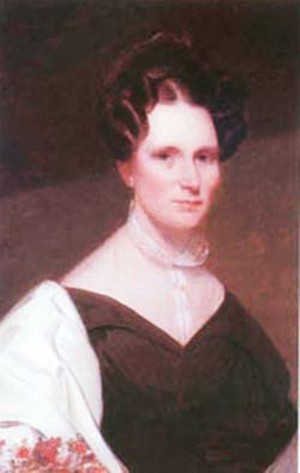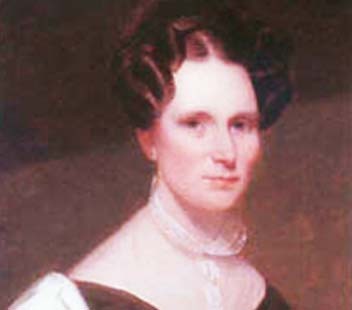
PHOTOS FROM COLLECTION OF THE HISTORICAL SOCIETY OF QUINCY AND ADAMS COUNTY
Christiana Holmes Tillson
Christiana Holmes Tillson was by birth and upbringing a New Englander of the sort too easily dismissed as the proper. She came to Illinois in 1822 with her husband, who had ventured west three years earlier and decided that Montgomery County – conveniently cleansed of Native Americans and thus a blank slate on which ambitious Americans might write their own futures – was a good place to make a new life.
Many years later, in 1870, Mrs. Tillson, by then aging, ailing and widowed, wrote a memoir of those years for the benefit of her youngest daughter. The book was reissued in 1919 as A Woman’s Story of Pioneer Illinois, and again in 1996 by the Southern Illinois University Press.
Woman’s Story is fairly typical of the genre that constituted virtually the whole of Illinois literature for many years, being part travel book, part family history, part adventure story. Our hero tells us about the awful food, the worse roads, the crude houses, the illnesses made more frightening by isolation. She raises a child, she has troubles with the help, she learns about (though she never quite approves of) the alien Southerners who were contemptuously referred to by her friends as “white folks.”
Her story has no drama of the vulgar sort – no Indian attacks, no deaths in the family, no prairie fires. Why read it then? As I noted, I did for the pleasure of the author’s company. Here is Tillson’s wonderfully deft portrait of the family in charge of a Shawneetown inn where she stayed on her way to Montgomery County.
The landlord – a poor white man from the South – was a whiskey keg in the morning, and a keg of whiskey at night; stupid and gruff in the morning, by noon could talk politics and abuse the Yankees, and by sundown was brave for a fight. His wife kept herself in the kitchen; his daughters – one married and two single – performed the agreeable to strangers; the son-in-law, putting on the airs of a gentleman, presided at the table, carving the pork, dishing out the cabbage, and talking big about his political friends.
The editor of the 1919 edition, Milo Milton Quaife, did not exaggerate when he noted that in material terms a pioneer in rural Illinois in 1820 would have more in common with her counterpart in Caesar’s Rome than she would with a farm wife in 1920. But in other respects Tillson’s Montgomery County seems a familiar enough place.
Anyone who’s built a new house will recognize what the Tillsons’ went through as they built the first brick house in Hillsboro, except for the bit about having to make the bricks in the backyard. Mrs. Tillson’s opinions of the preachers of the day – “ranting outranted” demonstrating “arrogance and self-display and…unblushing impudence” – could be applied to many of their TV versions from the pulpit and the stump. The author’s other half even had a tedious commute from their farm to a government job in the nearest big town; his didn’t involve being stuck at traffic lights but crossing a creek in the winter with water up to his saddle.
Mr. Tillson was a land speculator, storekeeper, postmaster and benefactor of improving institutions who went bust, with everyone else, in the Panic of 1837. (His story differs little from such Springfield men of the period as Pascal Enos, whom he knew.) Mrs. Tillson helped her husband in his postal work but unfortunately we learn little about his business dealing and adventures in town-building. Tillson on either would have been worth reading.
The domestic focus does, however, make Tillson’s memoir the more valuable. The lives of women have been too seldom a part of conventional histories. Happily, Tillson’s is one of three classic pioneer reminiscences written by women recalling their lives in mid-Illinois. (The other two are A True Picture of Emigration by Rebecca Burlend, who homesteaded in Pike County, and Life in Prairie Land by Eliza Farnham, a New York-born feminist who lived for nearly five years in Tazewell County.)
The man Tillson wed was sober and industrious and kind and thus far from typical. Poor women were obliged to work like draft animals in large part because their husbands and fathers treated them as such; Tillson’s portrait of one Brice Hanna, who made his young wife so miserable she clumsily tried to kill herself by jumping down a well, is chilling. But even Mrs. Tillson was obliged to toil; the page she devotes to candle-making makes clear why the process remained so vividly in her mind after a half-century. It also reminds us that the reason we read such books is not only to understand how different the past was but to understand how different the present has become.
Contact James Krohe Jr. at [email protected].


